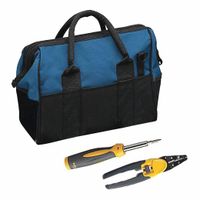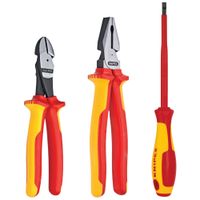Call +(254) 703 030 000 / 751 483 999 / 721 704 777
- Home
- Tools
- Hand Tools
- Assorted Tool Sets Kits
- Electrical Communications Electronics Tool Sets
.....Read More
Frequently Asked Questions
What are the essential tools in an electrical tool set?
An essential electrical tool set typically includes the following tools:
1. **Screwdrivers**: Insulated flathead and Phillips screwdrivers for tightening and loosening screws.
2. **Pliers**: Needle-nose, lineman's, and diagonal cutting pliers for gripping, twisting, and cutting wires.
3. **Wire Strippers**: For removing insulation from electrical wires without damaging the conductors.
4. **Multimeter**: A digital or analog device for measuring voltage, current, and resistance.
5. **Voltage Tester**: A non-contact tool to check for the presence of voltage in a circuit.
6. **Fish Tape**: Used to pull wires through conduits and walls.
7. **Cable Cutters**: For cutting through thicker cables and wires.
8. **Crimping Tool**: For attaching connectors to the ends of cables.
9. **Utility Knife**: For cutting insulation, tape, and other materials.
10. **Tape Measure**: For measuring lengths of wire and distances for installations.
11. **Level**: Ensures that installations are straight and properly aligned.
12. **Electrical Tape**: For insulating wires and other connections.
13. **Wire Nuts**: For connecting wires together safely.
14. **Conduit Bender**: For bending conduits to fit around obstacles.
15. **Flashlight or Headlamp**: Provides light in dark or dimly lit work areas.
16. **Tool Belt or Bag**: For organizing and carrying tools efficiently.
17. **Safety Gear**: Insulated gloves, safety glasses, and hard hats for personal protection.
These tools are fundamental for performing a wide range of electrical tasks, from basic repairs to complex installations, ensuring safety and efficiency in electrical work.
How do insulated tools differ from standard electrical tools?
Insulated tools are specifically designed to protect users from electrical shock when working with live circuits, whereas standard electrical tools do not offer this level of protection. The primary difference lies in the insulation material and construction.
1. **Insulation Material**: Insulated tools are coated with a non-conductive material, typically a durable plastic or rubber, which can withstand high voltages. This insulation is usually rated to protect against voltages up to 1000 volts AC or 1500 volts DC, depending on the tool and manufacturer.
2. **Construction**: Insulated tools undergo rigorous testing to ensure they meet safety standards, such as those set by the International Electrotechnical Commission (IEC) or the American Society for Testing and Materials (ASTM). They are designed to prevent accidental contact with conductive parts, reducing the risk of electrical shock.
3. **Identification**: Insulated tools are often marked with a double triangle symbol and a voltage rating, indicating their suitability for electrical work. They may also have a distinct color, such as orange or red, to differentiate them from standard tools.
4. **Safety Standards**: Insulated tools must comply with specific safety standards, such as IEC 60900 or ASTM F1505, which outline the requirements for design, testing, and performance. These standards ensure that the tools provide adequate protection against electrical hazards.
5. **Usage**: Insulated tools are essential for electricians and technicians who work on or near live electrical circuits. They provide an additional layer of safety, reducing the risk of injury or fatality from electrical shock.
In contrast, standard electrical tools lack this specialized insulation and are not safe for use on live circuits, as they do not provide protection against electrical shock.
What tools are included in a communications tool set?
A comprehensive communications tool set typically includes a variety of tools designed to facilitate effective communication across different platforms and for various purposes. These tools can be categorized as follows:
1. **Email Clients**: Tools like Microsoft Outlook, Gmail, and Apple Mail are essential for formal and asynchronous communication.
2. **Instant Messaging Apps**: Platforms such as Slack, Microsoft Teams, and WhatsApp allow for real-time, informal communication and quick exchanges.
3. **Video Conferencing Software**: Zoom, Google Meet, and Microsoft Teams enable virtual face-to-face meetings, webinars, and presentations.
4. **Project Management Tools**: Applications like Trello, Asana, and Monday.com help in organizing tasks and facilitating communication within teams.
5. **Collaboration Platforms**: Tools such as Google Workspace and Microsoft 365 offer integrated solutions for document sharing, editing, and collaborative work.
6. **Social Media Platforms**: Facebook, Twitter, LinkedIn, and Instagram are used for external communication, marketing, and engagement with a broader audience.
7. **Content Management Systems (CMS)**: WordPress and Joomla are used for creating and managing digital content, facilitating communication through blogs and websites.
8. **Customer Relationship Management (CRM) Software**: Salesforce and HubSpot help manage interactions with customers and clients, streamlining communication and sales processes.
9. **Survey and Feedback Tools**: Platforms like SurveyMonkey and Google Forms are used to gather feedback and insights from stakeholders.
10. **File Sharing Services**: Dropbox, Google Drive, and OneDrive allow for secure sharing and storage of documents and media.
11. **Voice Over Internet Protocol (VoIP) Services**: Skype and RingCentral provide internet-based voice communication.
12. **Internal Communication Platforms**: Intranets and employee portals facilitate internal communication and information dissemination within organizations.
These tools collectively enhance communication efficiency, collaboration, and information sharing in both personal and professional settings.
How do you choose the right tool set for network installation?
To choose the right tool set for network installation, consider the following factors:
1. **Project Scope**: Determine the size and complexity of the network. Larger projects may require advanced tools like cable testers, network analyzers, and crimping tools, while smaller setups might only need basic tools.
2. **Network Type**: Identify whether the network is wired, wireless, or a combination. Wired networks require tools for cable management and testing, while wireless networks might need spectrum analyzers and signal strength meters.
3. **Compatibility**: Ensure tools are compatible with the network components, such as cables, connectors, and devices. For example, tools for fiber optic networks differ from those for copper networks.
4. **Quality and Reliability**: Invest in high-quality, durable tools from reputable brands to ensure accuracy and longevity. Poor-quality tools can lead to installation errors and increased maintenance costs.
5. **Budget**: Balance between cost and quality. While it's important to stay within budget, prioritize essential tools that offer the best value and performance.
6. **Skill Level**: Consider the expertise of the installation team. Complex tools may require specialized training, so choose tools that match the team's skill level or provide necessary training.
7. **Future-Proofing**: Select tools that can accommodate future network expansions or upgrades, ensuring long-term usability.
8. **Vendor Support**: Opt for tools from vendors that offer good customer support, warranties, and easy access to replacement parts or accessories.
9. **Regulatory Compliance**: Ensure tools meet industry standards and regulations to avoid legal issues and ensure network safety and performance.
10. **User Reviews and Recommendations**: Research user reviews and seek recommendations from industry professionals to gauge tool effectiveness and reliability.
By considering these factors, you can select a tool set that meets the specific needs of your network installation project.
What safety precautions should be taken when using electrical tool sets?
1. **Read the Manual**: Always read the manufacturer's instructions and safety guidelines before using any electrical tool.
2. **Inspect Tools**: Check for any damage, such as frayed cords, cracked casings, or loose parts, before use. Do not use damaged tools.
3. **Use Proper PPE**: Wear appropriate personal protective equipment, including safety goggles, gloves, and hearing protection, as necessary.
4. **Dry Environment**: Ensure the work area is dry and free from moisture to prevent electrical shock.
5. **Proper Lighting**: Work in a well-lit area to avoid accidents and ensure precision.
6. **Correct Tool for the Job**: Use the right tool for the task to prevent overloading and damage.
7. **Avoid Overloading Circuits**: Do not plug too many tools into a single outlet to prevent overheating and potential fire hazards.
8. **Secure Work Area**: Keep the work area clean and free of clutter to avoid tripping hazards.
9. **Use Ground Fault Circuit Interrupters (GFCIs)**: Use GFCIs in damp or wet locations to prevent electrical shock.
10. **Disconnect When Not in Use**: Unplug tools when not in use or when changing accessories to prevent accidental activation.
11. **Proper Storage**: Store tools in a dry, secure place to prevent damage and unauthorized use.
12. **Avoid Loose Clothing**: Do not wear loose clothing or jewelry that could get caught in moving parts.
13. **Use Both Hands**: Maintain a firm grip and use both hands when operating tools to ensure control.
14. **Ventilation**: Ensure proper ventilation when using tools that produce dust or fumes.
15. **Training**: Ensure all users are properly trained in the use and safety of the tools.
16. **Emergency Procedures**: Be aware of emergency procedures and have a first aid kit readily available.
How do you maintain and store electrical and electronics tool sets?
To maintain and store electrical and electronics tool sets effectively, follow these steps:
1. **Cleaning**: Regularly clean tools with a soft cloth to remove dust and debris. Use isopropyl alcohol for metal parts to prevent corrosion.
2. **Inspection**: Frequently inspect tools for wear and damage. Replace or repair any faulty tools to ensure safety and efficiency.
3. **Calibration**: Periodically calibrate measurement tools like multimeters to maintain accuracy.
4. **Lubrication**: Apply appropriate lubricants to moving parts of tools like pliers and cutters to ensure smooth operation.
5. **Storage**: Store tools in a dry, cool environment to prevent rust and degradation. Use toolboxes or cabinets with compartments to organize tools by type and size.
6. **Labeling**: Clearly label storage compartments for easy identification and retrieval of tools.
7. **Protection**: Use protective cases for sensitive instruments to shield them from impact and environmental damage.
8. **Inventory Management**: Keep an inventory list to track tools and ensure none are misplaced or lost.
9. **Training**: Ensure all users are trained in proper tool handling and maintenance procedures.
10. **Usage Guidelines**: Follow manufacturer guidelines for tool usage to prevent misuse and extend tool life.
11. **Environment Control**: Maintain a controlled environment with stable temperature and humidity to protect electronic tools.
12. **Safety**: Store tools with sharp edges or points in protective sheaths to prevent injury.
13. **Regular Updates**: Update tool sets with new technologies and replace outdated tools to maintain efficiency.
By adhering to these practices, you can ensure the longevity and reliability of your electrical and electronics tool sets.
What are the best brands for electrical and electronics tool sets?
Some of the best brands for electrical and electronics tool sets include:
1. **Klein Tools**: Known for high-quality hand tools, Klein Tools offers a wide range of electrical tool sets that are durable and reliable, making them a favorite among professionals.
2. **Fluke**: Specializing in electronic test tools and software, Fluke provides comprehensive tool sets that include multimeters, testers, and other essential instruments for electronics work.
3. **Wiha**: Renowned for precision and quality, Wiha offers tool sets that are ideal for electronics work, featuring insulated tools and ergonomic designs for safety and comfort.
4. **Wera**: Wera is known for its innovative tool designs and high-quality materials, offering tool sets that include screwdrivers, wrenches, and other essential tools for electrical work.
5. **Bosch**: A leader in power tools, Bosch also provides excellent tool sets for electrical and electronics applications, known for their durability and advanced technology.
6. **Greenlee**: Specializing in tools for the electrical industry, Greenlee offers a variety of tool sets that include everything from basic hand tools to advanced testing equipment.
7. **Stanley**: A well-known brand for hand tools, Stanley offers affordable and reliable tool sets suitable for both professionals and DIY enthusiasts in the electrical field.
8. **Milwaukee**: Known for its power tools, Milwaukee also offers high-quality hand tool sets for electrical work, featuring innovative designs and robust construction.
9. **Ideal Industries**: Ideal provides a range of electrical tool sets that are well-regarded for their quality and functionality, including wire strippers, pliers, and testers.
10. **DeWalt**: DeWalt is recognized for its durable and high-performance tools, offering comprehensive tool sets that cater to both electrical and electronics professionals.
These brands are known for their commitment to quality, innovation, and reliability, making them top choices for electrical and electronics tool sets.


